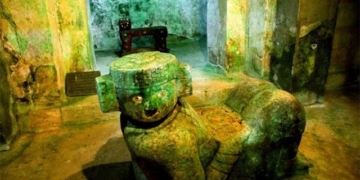According to a new study published on August 9, NASA’s Curiosity rover has discovered the first evidence indicating that Mars once had a climate characterized by alternating dry and wet seasons similar to Earth. This suggests that the “Red Planet” may have once been a suitable environment for life.
Billion of years ago, vast rivers and lakes are believed to have stretched across the surface of Mars before transforming into the arid desert we see today. The first evidence was found in 2012, following the Curiosity rover’s exploration of the enormous Gale Crater – previously thought to have contained a lake and a massive sedimentary mountain nearly 6 km tall at its center.

InSight lander preparing to land on the surface of Mars, November 2018. (Photo: AFP/TTXVN).
The study published in Nature states that while climbing the sedimentary mountain in 2021, the Curiosity rover discovered hexagonal salt deposits in soil dating back nearly 4 billion years, identifying these as cracks in dried mud – signs of a lake that had dried up. According to William Rapin, a researcher at the French National Centre for Scientific Research (CNRS) and the lead author of the study, this is the first tangible evidence that Mars had a cyclical climate. The occurrence of rainy and dry seasons similar to Earth suggests that Mars could have had the necessary conditions to support the emergence of life.
The Curiosity rover has also detected the presence of organic compounds considered the building blocks of life on Mars. However, these compounds require the right conditions to become precursors of life. Rapin explains that in an overly arid world, these molecules would never have the chance to form. If life ever existed on Mars, it could have been in the form of primitive single-celled microorganisms.
Ashwin Vasavada, a specialist at NASA’s Jet Propulsion Laboratory (JPL), shared that for over 11 years, researchers have tirelessly searched for evidence showing that ancient Mars could have been a habitable environment for microorganisms, thanks to the Curiosity rover. Now, the research team has found evidence of conditions that may have spurred the origins of life.
According to this expert, discovering such ancient terrain could never be achieved on Earth, where tectonic plates continuously disturb the surface and erase traces of the past. Therefore, studying Mars – which lacks tectonic plates – can help scientists unravel the mystery of how life began to form on our “Blue Planet.”


















































